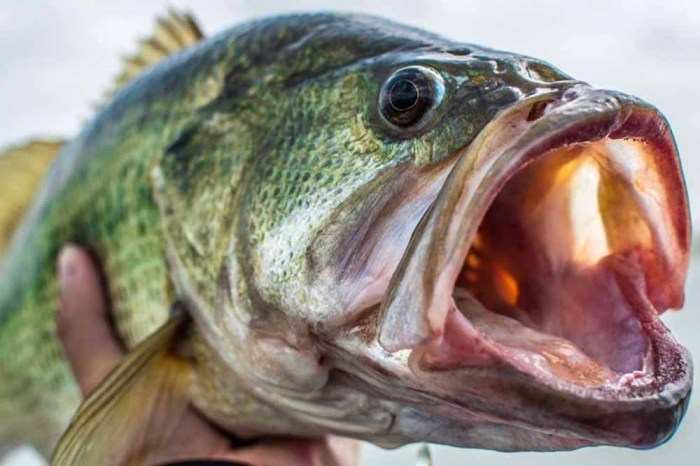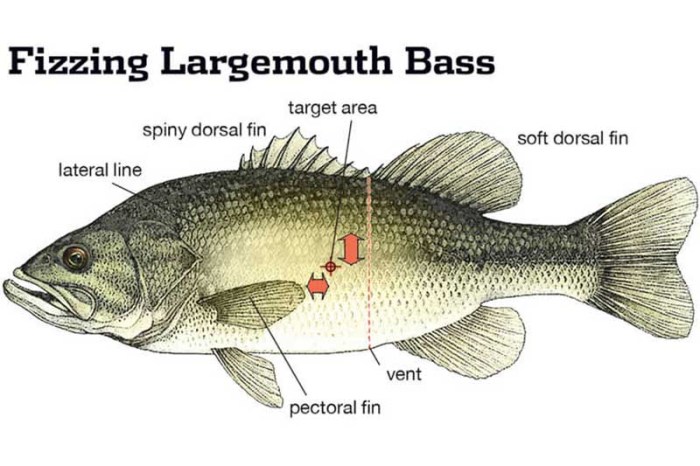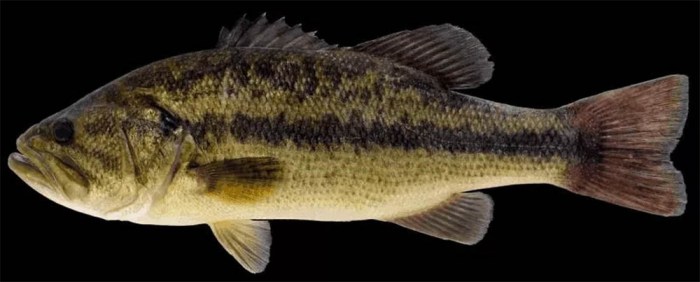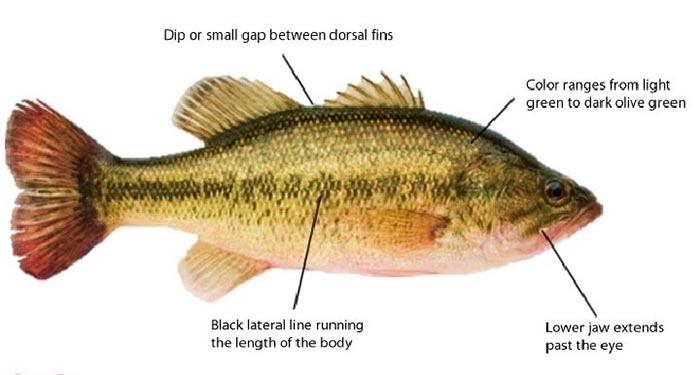Anatomy of a largemouth bass – Embark on a fascinating journey into the anatomy of the largemouth bass, a species renowned for its impressive size and predatory prowess. From its distinctive external features to its intricate internal systems, we delve into the complexities that define this captivating fish.
With a sleek, torpedo-shaped body adorned with a massive mouth, the largemouth bass exhibits an array of adaptations that enable it to thrive in its aquatic environment. Its external anatomy reveals key features such as its large scales, sharp fins, and intricate coloration, which vary depending on habitat.
External Anatomy

Largemouth bass are known for their distinctive body shape and features. They have a laterally compressed body, meaning their bodies are flattened from side to side, giving them a streamlined shape that allows for quick and agile movements in the water.
The size of largemouth bass can vary depending on the species, but on average, they can range from 12 to 24 inches in length and weigh between 1 to 10 pounds. Some largemouth bass have even been known to grow larger, reaching lengths of up to 30 inches and weighing over 20 pounds.
Fins
Largemouth bass have several fins that help them navigate and maintain balance in the water. The dorsal fin is located on the back of the fish and is divided into two parts. The first part, known as the spiny dorsal fin, consists of 10 to 13 spines, while the second part, called the soft dorsal fin, contains 12 to 15 soft rays.
The anal fin is located on the underside of the fish, behind the anus, and consists of three spines and 10 to 12 soft rays. The pectoral fins are located on the sides of the fish, just behind the gill covers, and help with steering and balance.
The pelvic fins are located on the underside of the fish, just behind the pectoral fins, and are used for stability and maneuvering.
Scales
Largemouth bass have scales that cover their entire body, providing protection and reducing water resistance. These scales are known as ctenoid scales and have a rough, comb-like texture.
The largemouth bass, known for its impressive size and distinctive features, has a unique anatomy that makes it a formidable predator. Its massive jaws are lined with sharp teeth, allowing it to capture and devour prey. To learn more about the anatomy of this fascinating fish and other related topics, be sure to check out unit 4 session 8 letrs . Returning to our discussion on the largemouth bass, its muscular body and powerful tail fin enable it to swim swiftly and maneuver through the water with ease.
Mouth
The mouth of a largemouth bass is one of its most distinctive features. It is large and extends beyond the eyes, giving the fish its characteristic “largemouth” appearance. The mouth is lined with small, sharp teeth that are used for grasping and holding prey.
Coloration and Patterns
The coloration and patterns of largemouth bass can vary depending on the environment in which they live. In clear waters, they tend to have a light green or brown coloration with dark green or brown vertical bars on their sides.
In murky waters, they may have a darker coloration with less distinct markings.
Internal Anatomy

The internal anatomy of a largemouth bass is complex and efficient, supporting its predatory lifestyle.
Digestive System
The digestive system of a largemouth bass begins with the mouth, where sharp teeth help to capture and tear prey. The esophagus then transports the food to the stomach, where it is broken down by enzymes and acids. The partially digested food then moves into the intestines, where nutrients are absorbed and waste products are eliminated.
Respiratory System
The respiratory system of a largemouth bass consists of gills, a swim bladder, and lungs. The gills are located on the sides of the head and extract oxygen from the water. The swim bladder is a gas-filled sac that helps the fish to maintain its buoyancy.
The lungs are located near the gills and allow the fish to breathe air when necessary.
Circulatory System
The circulatory system of a largemouth bass consists of a heart, blood vessels, and blood. The heart pumps blood throughout the body, delivering oxygen and nutrients to the cells and removing waste products. The blood vessels are a network of tubes that carry blood throughout the body.
The blood is made up of red blood cells, white blood cells, and platelets.
Skeletal System

The skeletal system of a largemouth bass provides support, protection, and allows for movement. It consists of bones, cartilage, and ligaments. The bones of the head, body, and fins are all connected by ligaments, which allow for flexibility and movement.
Bones of the Head
The bones of the head protect the brain and other vital organs. They also provide attachment points for muscles that control movement of the head and jaws. The bones of the head include the cranium, which encloses the brain, and the jaws, which are used for biting and chewing.
Bones of the Body
The bones of the body support the weight of the fish and protect the internal organs. They also provide attachment points for muscles that control movement of the body. The bones of the body include the vertebrae, which make up the backbone, and the ribs, which protect the heart and lungs.
Bones of the Fins
The bones of the fins support the fins and allow for movement. The fins are used for swimming, steering, and balance. The bones of the fins include the rays, which support the fin, and the spines, which protect the fin from damage.
Differences Between the Skeletal System of a Largemouth Bass and Other Fish Species
The skeletal system of a largemouth bass is similar to that of other fish species, but there are some key differences. For example, the largemouth bass has a more robust skull than other fish species, which helps to protect its brain from predators.
Additionally, the largemouth bass has a more flexible backbone than other fish species, which allows it to swim more quickly and maneuver more easily.
Muscular System

The muscular system of a largemouth bass is complex and allows the fish to move and swim efficiently. The muscles are arranged in a series of myotomes, or muscle segments, that run along the length of the body. Each myotome is innervated by a pair of spinal nerves, and the muscles are controlled by the central nervous system.
Head Muscles, Anatomy of a largemouth bass
The head muscles of a largemouth bass are responsible for a variety of movements, including feeding, respiration, and vision. The most prominent head muscles are the adductor mandibulae, which close the jaw, and the levator arcus palatini, which raise the gill arches.
Body Muscles
The body muscles of a largemouth bass are responsible for locomotion. The most important body muscles are the epaxial muscles, which run along the back of the fish, and the hypaxial muscles, which run along the belly of the fish.
The epaxial muscles contract to bend the body to the side, while the hypaxial muscles contract to bend the body up and down.
Fin Muscles
The fin muscles of a largemouth bass are responsible for controlling the movement of the fins. The most important fin muscles are the abductor and adductor muscles, which control the movement of the pectoral fins, and the flexor and extensor muscles, which control the movement of the dorsal and anal fins.
The muscular system of a largemouth bass is similar to that of other fish species. However, there are some key differences. For example, the largemouth bass has a more developed muscular system than many other fish species, which allows it to swim faster and more powerfully.
Nervous System
The nervous system of a largemouth bass is a complex network of specialized cells that control the body’s functions, behaviors, and responses to the environment. It consists of the brain, spinal cord, and nerves that extend throughout the body.The brain, located in the skull, is the central processing unit of the nervous system.
It receives sensory information from the environment, processes it, and sends commands to the body to control movement, behavior, and homeostasis. The spinal cord, which runs along the back of the fish, transmits nerve impulses between the brain and the rest of the body.
Nerves, which are bundles of nerve fibers, carry sensory and motor signals to and from the brain and spinal cord.
Brain
The brain of a largemouth bass is divided into several regions, each with specific functions. The forebrain includes the olfactory bulbs, which are responsible for smell, and the cerebrum, which is involved in higher-order functions such as learning, memory, and behavior.
The midbrain is responsible for vision and hearing, and the hindbrain controls balance, respiration, and circulation.
Spinal Cord
The spinal cord is a long, cylindrical structure that runs along the back of the fish. It transmits nerve impulses between the brain and the rest of the body. The spinal cord also contains nerve cells that control reflexes, which are automatic responses to stimuli.
Nerves
Nerves are bundles of nerve fibers that carry sensory and motor signals to and from the brain and spinal cord. Sensory nerves transmit information from the body to the brain, while motor nerves carry commands from the brain to the muscles and organs.The
nervous system of a largemouth bass is similar to that of other fish species, but there are some differences. For example, the largemouth bass has a relatively large olfactory bulb, which reflects its reliance on smell for finding food and mates.
Sensory Organs

Largemouth bass possess an array of sensory organs that enable them to detect and respond to their environment. These organs include eyes, ears, nose, and taste buds, each serving a specific function.
Eyes
Largemouth bass have large, forward-facing eyes that provide them with excellent binocular vision. This allows them to accurately judge distances and detect prey. Their eyes are adapted to low-light conditions, enabling them to hunt effectively at dawn and dusk.
Ears
Largemouth bass do not have external ears, but they possess a pair of inner ears located on either side of their heads. These ears are used for balance and hearing. They can detect vibrations in the water, allowing them to locate prey and avoid predators.
Nose
The nose of a largemouth bass is located on the top of its head. It is used to detect odors in the water, which can provide information about food, predators, and other environmental cues.
Taste Buds
Largemouth bass have taste buds located on their lips, tongue, and inside their mouths. These taste buds allow them to detect the chemical composition of food and water, helping them to identify potential food sources.The sensory organs of largemouth bass are well-suited to their predatory lifestyle.
Their excellent vision, hearing, and ability to detect odors and tastes enable them to locate prey, avoid predators, and navigate their environment effectively. These sensory organs also exhibit variations among different fish species, reflecting their unique adaptations to their respective habitats and ecological niches.
Reproductive System: Anatomy Of A Largemouth Bass
The reproductive system of a largemouth bass consists of the gonads, which produce gametes, and the reproductive ducts, which transport the gametes to the outside of the body. The testes are the male gonads, while the ovaries are the female gonads.
The reproductive ducts in males are the vas deferens, which transport sperm from the testes to the outside of the body, and the seminal vesicles, which produce seminal fluid. The reproductive ducts in females are the oviducts, which transport eggs from the ovaries to the outside of the body, and the uterus, which provides a place for the eggs to develop into embryos.
The reproductive system of a largemouth bass allows the fish to reproduce by producing and releasing gametes, which can then combine to form a zygote. The zygote develops into an embryo, which eventually hatches into a larva. The larva then develops into a juvenile fish, which eventually matures into an adult fish.
Differences from Other Fish Species
The reproductive system of a largemouth bass is similar to that of other fish species, but there are some key differences. For example, largemouth bass are sexually dimorphic, meaning that males and females have different physical characteristics. Males are typically larger than females and have a more streamlined body shape.
Females have a more rounded body shape and a larger belly. Additionally, largemouth bass are multiple spawners, meaning that they can produce multiple batches of eggs throughout the spawning season.
General Inquiries
What is the distinctive feature of a largemouth bass?
The largemouth bass is renowned for its massive mouth, which extends beyond the rear margin of its eye.
How does the largemouth bass’s coloration vary?
The coloration of a largemouth bass can vary greatly depending on its habitat, ranging from light green to dark brown, with patterns of spots or stripes.
What is the function of the swim bladder in a largemouth bass?
The swim bladder is a gas-filled sac that helps the largemouth bass maintain buoyancy and control its depth in the water.